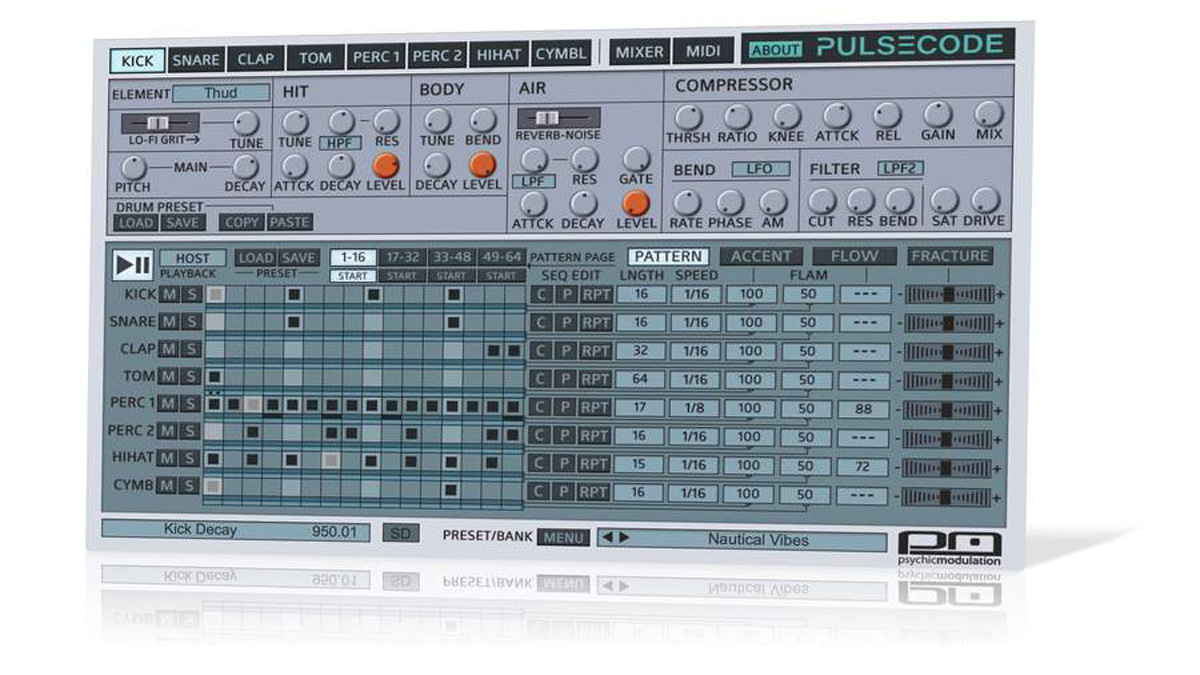MusicRadar Verdict
Old-school sounds meet contemporary sequencing in this stellar beatbox.
Pros
- +
Fabulously crunchy sounds.
- +
Straightforward, flexible sequencing.
- +
Accent, Flow and Fracture features rock.
- +
Great preset library.
Cons
- -
No global effects.
- -
No sample import.
- -
No sequencer swing control.
MusicRadar's got your back
As demonstrated by the superb Phonec 2 and EchoMelt, Psychic Modulation is a master of retro instrument and effects design.
Its new drum machine, PulseCode (VST/AU), “pays tribute to the gritty, lo-fi sounds from the late 1980s”, presenting a built-in library of 12- and 13-bit acoustic and electronically sourced drum, percussion and other (basses and FX) samples, in an interface that aims to replicate the layering techniques used by the producers of that era.
On the Pulse
At first glance, PulseCode’s crude GUI elements and dull colour scheme are a little offputting. Get past that, though, and the interface reveals itself to be practical and intuitive, governing a fairly deep architecture via two tabbed panes.
The drum kit is made up of eight specific engines: Kick, Snare, Clap, Tom, Perc 1, Perc 2, HiHat and Cymbal, mixed and routed to up to eight outputs in the Mixer tab. Each engine offers a menu of Elements (sounds) of its type, ranging in number from 23 Claps to 58 Percs, but all are identical in terms of controls. Every Element consists of four layers, between them employing six samples, and all affected equally by the left-most Pitch and Decay knobs.
The first layer is the Core, comprising blendable ‘regular’ and lo-fi versions of the main sound, the latter detunable. The Hit layer adds a tunable transient, and features its own resonant multimode filter and AD envelope, while the Body layer bolsters the bottom end (or simply duplicates the Core layer for Elements where that wouldn’t be appropriate - HiHats, for example) with control over tuning and Decay, and a depth knob for the Bend modulator (see below). The Air layer enables free mixing of reverb and noise samples, and incorporates the same filter and envelope as the Hit layer, plus a gate that mimics sidechaining off the Core layer, for generating gated reverb and other effects.
The Flow and Fracture systems in PulseCode serve users with cyclical and manually controlled modulation.
Flow is essentially a per-engine host-synced LFO for modulating Amplitude, Decay and Pan, cycling over 1-16 steps and triggered by pattern start or Accent steps. The Phase of the wave is tweakable, random deviation can be dialled in, and each engine is assignable to Modwheel by raising its individual Amount setting in the MIDI tab.
Fracture control is a real-time fill generator that randomly messes with the Pitch and Step triggers of its host engine, snapping back to centre when released unless Latch mode is on. Pushed right, the pattern gets busier and pitchshifting is generally upwards; pushed left, the sequence thins and pitch changes mostly downwards. Pitch and Step modulation depths are adjustable, and the Pitch wheel is variably assignable to multiple Fracture controls for hands-on performance.
Every Element also has its own compressor, filter and saturation/distortion stage, and modulation of the filter, amplitude and Body layer pitch can be applied with the Bend modulator, which switches between normal and high-frequency LFOs.
The step sequencer includes Accent and Flam (up to five repeats) sub-lanes, and allows each lane to be set to anywhere between 1 and 64 steps long for polyrhythmic grooves, at regular, dotted and triplet rates from 1/1 to 1/32. You can have four 16-step patterns in a patch, with lanes running into the next pattern if they exceed the bounds of the active one. Cleverly, the Accent lane can be used to independently modulate Decay, Pitch and Filter cutoff as well as volume, while the Drum Fill Arpeggiator enables triggering of multi-engine rolls via MIDI note input - an interesting idea, certainly, but quite limited in scope. There’s also no swing control at at all in the sequencer, it’s worth noting.
’Code warrior
PulseCode nails that grainy vintage vibe, and provides a powerful array of tools for shaping and sequencing its evocative onboard sounds. The inability to load external samples is disappointing (expansion will only be possible through a forthcoming series of proprietary packs); global EQ, compression and saturation wouldn’t go amiss; and swing needs adding (it’s on the roadmap and coming soon, we’re told). But anyone working at the more abrasive end of electronic music will have a field day with this idiosyncratic, inspiring instrument.
Computer Music magazine is the world’s best selling publication dedicated solely to making great music with your Mac or PC computer. Each issue it brings its lucky readers the best in cutting-edge tutorials, need-to-know, expert software reviews and even all the tools you actually need to make great music today, courtesy of our legendary CM Plugin Suite.
“Even my cat is disappointed in me”: Deadmau5 gets drunk at Coachella, falls over, is escorted off stage by security, and apologises
“The last thing Billy and I wanted to do was retread and say, ‘Hey, let’s do another Rebel Yell.’ We’ve already done that”: Guitar hero Steve Stevens lifts the lid on the new Billy Idol album
"This $399 item will incur over $578 in additional import charges": Price of Sonicware CyDrums drum machine more than doubles thanks to Trump tariffs











